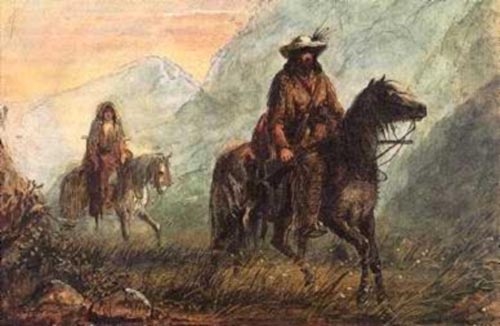
Bourgeois and Squaw, Alfred Jacob Miller, 1837.
The above painting depicts Joseph Reddeford Walker (1798-1876).
A bourgeois was a supervisor of other trappers. As noted on the previous page, there were three types of
trappers, those who were employees of the fur company and under the supervision of
the bourgeois, others who in exchange for outfitting by the company, contracted to sell all
their pelts to the company, and finally "free" trappers who provided their own outfits and were
not under any contractual obligation. Walker was a member of
the Bonneville and Fremont Expeditions and was also the first sheriff in
Independence, Missouri. With his familiarity of the west, including the
Sierras, he attempted to warn the Donner Party about the possible consequences of their
late departure. His warning was dismissed, however, as that of an "ignorant Missouri puke."
The most famous of the mountain men, James Felix Bridger (1804-1881), was born in Richmond, Virginia,
the son of an innkeeper. In addition to serving as a guide, he is credited for discovering
the Great Salt Lake, South Pass, and Bridger Pass. He visited Yellowstone and acted as a guide for Albert Sidney Johnston.
Additionally, he acted as a guide for Gen. G. M. Dodge's survey parties laying out the line for the Pacific Railroad. He was the son-in-law of
Chief Washakie. In the 1860's he returned to Westport, Missouri (now a part of Kansas City),
where he had a farm near present day 103rd St. and State Line, and operated with his son-in-law, Albert Wachsmann,
an outfitting business at present day 504 Westport Rd. The building still stands and is occupied by
a restaurant.
A. J. Shotwell, a private from Co. F, Eleventh Ohio Cavalry, recalled Bridger from an 1865 eight-day shared ride from
Ft. Laramie to Missouri. The two, along with a second soldier had intended to catch the eastbound Overland
Stage at Julesburg. Unfortunately, the stage was fully booked for the next ten days. Thus, the
three hitched a ride with an empty wagon train heading east. At each of the road ranches along
the way, Bridger was recognized, welcomed and money would not be accepted. Shotwell described Bridger as:
[W]ell proportioned form of slender mold, about six fee high -- probably a little less, possibly a trifle more, straight
as an Indian and quick in movement, but not nervous or excitable; in weight, probably one hundred and sixty pounds, with an eye as pierceing as the eye of an eagle; that
seemed to flash fire when narrating an experience that called out his reserve power. There was
nothing in his costume or deportment to indicate the heroic spirit that dwelt within -- simply a plain,
unassuming man, but made of heroic stuff, ever inch!
At the 1835 Rendezvous at the confluence of Horse Creek and the Green River, Dr. Marcus Whiteman
removed, to the amusement and amazement of the ensembled
multitudes, a three inch arrow or spearhead that had been lodged in Jim Bridger's shoulder for the
preceeding three years. The Reverend Samuel Parker in his 1838 self-published
Journal of an Exploring tour Beyond the Rocky Mountains, Under the Direction of the
A. B. C. F. M. Performed in the Years 1835, '36, and '37 described the
operation:
While we continued in this place, Doct. Whitman was called to perform some
very important surgical operations. He extracted an iron arrow, three inches long, from
the back of Capt. Bridger, which he had received in a skirmish three years
before, with the Blackfeet Indians. It was a difficult operation in consequence
of the arrow being hooked at the point by striking a large bone, and a
cartilaginous substance had grown around it. The doctor pursued the operation
with great self-possession and perserverance; and Capt. Bridger manifested equal firmness. The
Indians looked on while the operation was proceeding with countenances indicating wonder, and
when they saw the arrow, expressed their astonishment in a manner peculiar to themselves.
The skill of Doct. Whitman, undoubtedly made upon them a favorable impression. He also took
another arrow from the shoulder of one of the hunters, which had been there two
and a half.
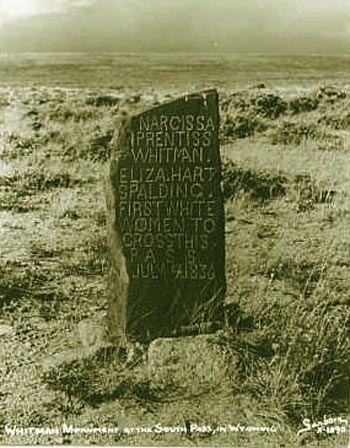 Monument to Narcissa Whitman and Eliza Spalding Hart, South Pass, Wyo.,
photo by William P. Sanborn
Monument to Narcissa Whitman and Eliza Spalding Hart, South Pass, Wyo.,
photo by William P. Sanborn
[Writer's note: "A. B. C. F. M." denotes the American Board of Commissioners for Foreign Missions,
which sponsored Congregational and Presbyterian missions.]
Bridger had received the arrow following the 1832 Rendezvous. He and Thomas Fitzpatrick were trapping
along the Jefferson Fork of the Missouri and had been followed by trappers led by Andrew Drips and Henry
Vanderburgh who, apparently, hoped to steal Bridger and Fitzpatrick's territory. Realizing that
they were being followed Bridger led the followers into Blackfoot territory. Dr. Hebard and E. A.
Brininstool in their The Bozeman Trail: Historical Accounts of the Blazing of the Overland
Routes into the Northwest, and the Fights with Red Cloud's Warriors, Arthur H. Clark Company, 1922, described
what happened:
The expected happened. The rivals were attacked on a stream which was one of the
sources of the Jefferson and Vanderburgh was killed, the Indians stripping his flesh from the bones and
throuwing the skeleton into the river. Bridger himself did not escape unscathed, for soon after he was
attacked by Indians of the same tribe. In the fight which folloed, Bridger and the
chief met in a desperate hand-to-hand encounter, during which the trapper received two severe arrow wounds in the
back, and was also felled to earth by a blow from his own gun, which the chief wrenched from his grasp.
Dr. Whitman returned
to the 1836 Rendezvous accompanied by his new bride, Narcissa Whitman, one of the
first two women to cross the continent to Oregon. The marriage was motivated at least in
part by the desire of both Dr. Whitman and Narcissa to become missionaries to the
Indians. The Board of Commissioners required missionaries be married. Thus, in
what may have been a marriage of convenience, the two were married in February 1836. Mrs.
Whitman, an alumna of Emma Willard's "Female Seminary," was "fine of voice." The last
hymn of the marriage ceremony was the maudlin Yes, My Native Land! I Love Thee. As the
singing continued, the congregation broke up in tears. The only one left
singing by the time of the final verse was the new Mrs. Whitman. The fifth verse:
In the deserts let me labor,
On the mountains let me tell
How he died--the blessed Savior--
To redeem a world from hell!
Let me hasten, Let me hasten,
Far in heathen lands to dwell;
Let me hasten, Let me hasten,
Far in heathen lands to dwell.
The Whitmans were later killed by Indians at their mission in Oregon. The hymn was also
sung by Mormon emigrants departing Britain as part of the Perpetual Emigrating
Fund Company.
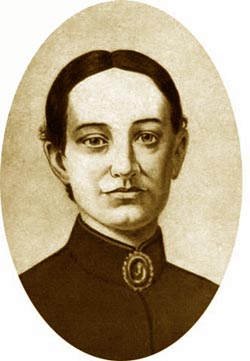 Narcissa Whitman
Narcissa Whitman
The procedures followed by the American Fur Company on the Rendezvous were described by
Dr. Whitman's fellow missionary, Henry Harmon Spalding (1803-1874) in an 1836 letter:
The company with which we Journeyed consisted of about 90 men, and 260 animals, mostly mules,
heavy loaded. At this camp we found about 300 men, and three times the number of animals,
employed by the Fur Company in taking furs, and about 2000 Indians, Snakes, Bonnaks, Flatheads,
and Nez Perces. Captain Steward [sic], an English gentleman of great fortune, and Mr. Seileim, a
German, traveled with us for discovery and pleasure, -- The order of the camp was as follows:
rise at half past 3, A. M. and turn out animals, march at 6, stop at 11, catch up and start
at 1, P. M., camp at 6, catch up and picket animals at 8; a constant guard night and day.
The intervals were completely taken up in taking care of animals, getting meals and seeing
to our effects, so that we had no time for rest from the time we left one post till we reached
another. When we reached this place, not only our animals but ourselves were nearly exhausted.
Our females endured the fatigues of the march remarkably well. Your ladies who ride on
horseback 10 or 12 miles over your smooth roads, and rest the remainder of the day and week,
know nothing of the fatigues of riding on horseback from morning till night day after day for
15 or 20 days, at the rate of 25 and 30 miles a day, and at night have nothing to lie on but
the hard ground. Truly we have reason to bless our God that our females are alive and enjoying
comparatively good health. The Fur Company showed us the greatest kindness throughout the whole
journey. We have wanted nothing which was in their power to furnish us.
The Reverend Spalding established his mission at Lapwai, Idaho, near present-day Lewiston. Following the massacre of
the Whitmans, the Spaldings evacuated to Oregon and, over, Spalding's protests, the A. B. C. F. M.
ordered the mission abandoned. Eliza Spalding died January 7, 1851.
At the 1837 Rendezvous, Capt. Sir William Drummond Stewart presented Bridger with a
replica suit of armor brought from Britain. Bridger, drunk, proceeded on horseback to clank around the rendezvous grounds in the armor.
Sir William, a veteran of Waterloo and an excellent marksman, attended each rendevous from 1833 to 1837,
bringing nothing but the finest provisions. Indeed, Sir William required 19 carts and 3 wagons together with a retinue of approximately
50 to meet his needs.
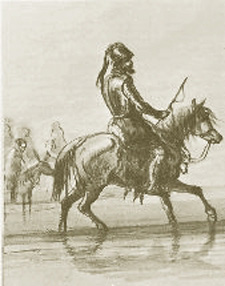 Bridger, drunk, 1837 Rendezvous, pencil sketch by Alfred Jacob Miller.
Bridger, drunk, 1837 Rendezvous, pencil sketch by Alfred Jacob Miller.
The 1837 Rendezvous was attended by more than 2,000 trappers, traders and Indians. Styles had already begun to change and top money
was not received for the furs. The Miller paintings are about our only accurate depictions of the
early mountain men. Later pictures by Remington and others were basically pictures of late 19th Century
trappers or from imagination.
Rufus B. Sage described the early mountaineers:
His skin, from constant exposure, assumes a hue almost as dark as that of the Aborigine,
and his features and physical structure attain a rough and hardy cast. His hair, through inattention, becomes long,
course, and bushy, and loosely dangles upon his shoulders. His head is surmounted by a low crowned
wool-hat, or a rude substitute of his own manufacture. His clothes are of buckskin,
gaily fringed at the seams with strings of the same material, cut and made in a fashion
peculiar to himself and associates. The deer and buffalo furnish him the required covering
for his feet, which he fabricates at the impules of want. His waist is encircled with a belt
of leather, holding encased his butcher-knife and pistols -- while from his neck
is suspended a bullet-pouch securely fastened to the belt in front, and beneath the right arm hands a
powder-horn transversely from his shoulder behind which, upon the strap attached to it, are affixed his
bullet-mould, ball-screw, wiper, awl, &c. With a gun-stick made of some hard wood, and a good
rufle, placed in his hands, carrying from thirty to thirty-five balls to the
pound, the reader will have before him a correct likeness of a genuine mountaineer, when fully equipped.
One of the more
distinctive [pardon the pun] attributes of the early mountain men was their aroma.
As noted by Jim Clyman in Journal of a Mountain Man, the early trappers not only refused to change their clothes but would
wipe their knives and hands on their clothes after eating or after skinning animals:
"...Naturally, if some of this mixture (speaking of castorium) spilled on
their hands, they wiped it on their buckskins; they didn't stop there, but
wiped their greasy hands on their skins after eating, and wiped off the
blood when skinning. The resulting color and flavor of the skin was not
the clean gold of fresh-tanned hides.
Instead, it was, as Don Berry says, "black. Dirty
black, greasy black, shiny black, bloody black, stinky black. Black."
[Writer's note: Castorium, an odoriferous oily secretion of the beaver, used in the making
of perfume.]
Of course, the trappers may not have been able to change their clothes. They often had but one set.
Thus, Captain Lee Humfreyville in his 1899 Twenty Years Among Our Hostile Indians noted an incident
with Jim Bridger:
During that winter, Bridger's suit of buckskin clothing (and it was all he had)
became infested with vermin, and in despair he at length asked me how he could get rid of them.
I told him if he would take off his buckskin jacket and breeches and wrap himself in a buffalo
robe, I would undertake to rid his clothes of the pests. He thereupon took his clothing off and turned it
inside out. After spreading the garments on the ground, I poured a ridge of gunpowder down the seams of
the suit, and touched it off. It burned the vermin, and it also burned the buckskin clothing
badly. On the seams of the leggins I had sprinkled so much powder that it burned the
garments to charred leather. They were drawn up short at the seams, and after being turned, each leg curled up unitl
it looked like a half-moon. Bridger looked at me for a moment in great disgust,
and then with a big oath said: "I am a-goin' to kill you for that." I was
afraid he would make his threat good, for he was certainly very indignant. I laughed at him, and
taking hold of the leggins I streched them into the best shape possible, but the leather was burned to brittleness and broke at the slightest
touch. Bridger did not forgive me for this until two or three days, during which time he was
compelled to go about in a buffalo robe until another buckskin suit could be procured.
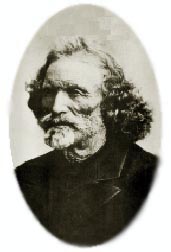 Jim Baker, undated
Jim Baker, undated
There was a value or purpose, however, to wiping the grease and other substances on the clothing.
David Lavender in Bent's Fort described the trapper's clothing:
"Down to his shoulders hung the hunter's hair, covered with a felt hat
or perhaps the hood of a capote. He liked wool clothing, for it would
not shrink as it dried and wake him, when he dozed beside the fire, by
agonizingly squeezing his limbs. But wool soon wore out and he then clad
himself in leather, burdensomely heavy to wear, fringed on the seams with
the familiar thongs which were partly to decorate but most utilitarian, to
let rain drip off the garment rather than soak in, and to furnish material
for mending. Further waterproofing was added by wiping butcher and eating
knifes on the garments until they were black and shiny with grease. Upper
garments might be pull-over type or cut like a coat, the buttonless edges
folded over and clinched into place with a belt. No underclothes were worn,
just breechclout. In extreme cold a Hudson's Bay blanket or a buffulo robe
was draped Indian-wise over the entire costume."
Some of the early mountain men never did get used to modern hygene. Jim Baker (1918-1898), who
served in the Fremont Expeditions, ultimately settled down in a two-story log
blockhouse between Dixon and Savery.
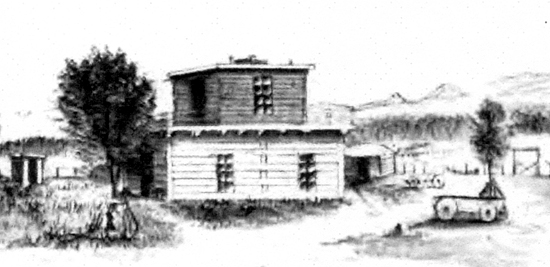
Baker Cabin, Dixon, Wyoming, 1899.
As noted above, the cabin was originally constructed between Dixon and Savery. In 1917 the State Legislature
appropriated $750.00 to purchase the cabin. It was moved to Frontier Park in Cheyenne.
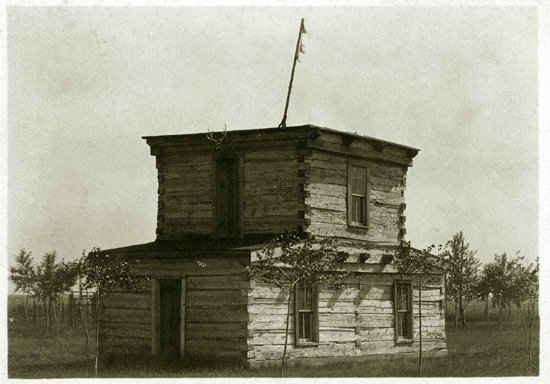
Baker Cabin, Frontier Park, Cheyenne, July 1920.
Photo by Lt. Flag A. Drewry, courtesy of Mary Carol Schrupp.
The above photo was taken by Lt. Drewry while he was on temporary duty for ten days at Fort D. A. Russell.
He was at D. A. Russell for examination for commissioning in the regular army. He was successful.
In 1976, the cabin was again moved from Cheyenne to Savery "on loan"
from the Wyoming State Museum. The various moves probably account for the concrete foundation visible in
the next photo.
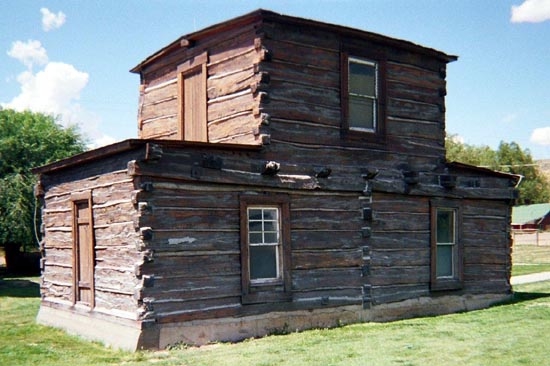
Baker Cabin, Savery Museum, 2003, photo by Geoff Dobson
In the late 1800's, Baker was as famous as Jim Bridger. His stories were quoted by numerous
writers including Mark Twain and Theodore Roosevelt. One of the more famous was his observations
on blue jays:
You may call a jay a bird. Well, so he is, in a
measureóbecause he's got feathers on him, and don't
belong to no church, perhaps; but otherwise he is
just as much a human as you be. And I'll tell you
for why. A jay's gifts, and instincts, and feelings,
and interests, cover the whole ground. A jay hasn't
got any more principle than a Congressman. A jay
will lie, a jay will steal, a jay will deceive, a jay will
betray; and four times out of five, a jay will go back
on his solemnest promise. The sacredness of an
obligation is a thing which you can't cram into no
blue-jay's head.
In 1895, Baker and John Albert, another early mountain man, were
invited to serve as marshals for Denver's very first Festival of Mountain and
Plain. The committee put him up in one of Denver's finest hotels. When it was
suggested he might like to take a bath, he informed them he did not need one -- he had one this
year. Additionally, he refused to sleep in the bed, preferring the floor, and
refused to use the flush toilet, preferring the alley behind the hotel.
Not all mountain men abstained from indoor plumbing. William Sublette's partner, Robert Campbell, was financially the
most sucessful of all the mountain men. Campbell moved from furs, to supplying the Army during the
Mexican War, to steamboats, railroads, hotels, and real estate, becoming a millionaire in the process.
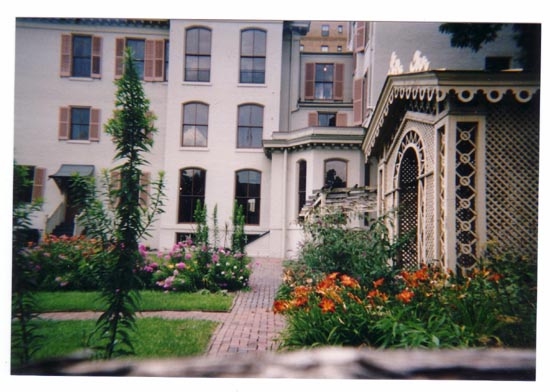
Robert Campbell House, St. Louis, 2003, photo by Geoff Dobson
Campbell's house
on 1508 Locust Street, St. Louis, was one suitable for entertaining the President of the United States, Ulysses S. Grant. Others
who passed through its elegant parlors included Father DeSmet, Gen. Sherman, Gen Harney, Washington Irving, as well as
Indian chiefs. The chiefs were allegedly served fire water from a silver punch bowl.
Another attribute of mountain men was their language. The Reverend Parker noted of the
mountain men:
In the absence of all those motives which they would feel in moral and
religious society, refinement, pride, a sense of the worth of character,
and even consceince, give place to unrestrained dissoluteness. Their
toils and privations are so great, that they are not disposed to take
upon themselves the labor of climbing up to the temple of sceince. And yet they
are proficients [Sic] in one study, the study of profuseness of language in
their oaths and blasphemy.
Moses "Black" Harris, an early Black
mountain man was a part of the Ashley expeditions to Yellowstone between 1822 to 1826.
Harris is credited as also assisting in the location of the site for Fort Laramie and for helping in its
original construction. Alfred Jacob Miller described Harris as being a wiry, muscular man with a leathery
cordlike blue-black skin as if burned by gunpowder. His epitaph reads:
HERE LIES THE BONES OF OLD BLACK HARRIS
WHO OFTEN TRAVELED BEYOND THE FAR WEST
AND FOR THE FREEDOM OF EQUAL RIGHTS,
HE CROSSED THE SNOWY MOUNTAIN HEIGHTS
WAS A FREE AND EASY KIND OF SOUL,
ESPECIALLY WITH A BELLY FULL.
Like many a mountainman, Harris was also known as a raconteur. To him is now
attributed the story of the petrified birds, sitting in the petrified trees with
petrified leaves in Yellowstone. The story became more and more elaborate with retelling
by others including Jim Bridger, Legh Freeman (see Ghost Towns) and
Anson Mills, until finally the birds were singing petrified songs.
The era of the mountain men came to a rapid decline. Less than 140 whites attended the 1840 Rendezvous and, with the expense of
bringing goods by wagon from St. Louis, it was announced that no further rendezvous would be held.
Notwithstanding that 1840 represented the last Rendezvous, in August 1843, Sir William sponsored a reunion of sorts
on the Green River near Fort Bridger. There, trappers and Indians gathered for
three days of horse racing, ball games, drinking, and story-telling.
Sir William provided some $500 worth of prizes for the fastest rider.
The winner was a naked Shoshoni known as "Indian Tom," riding a horse owned by
William Sublette. Indian Tom's only item of clothing was a red handkerchief.
Next page: The End of the Fur Trade and the Trapping Era.
|